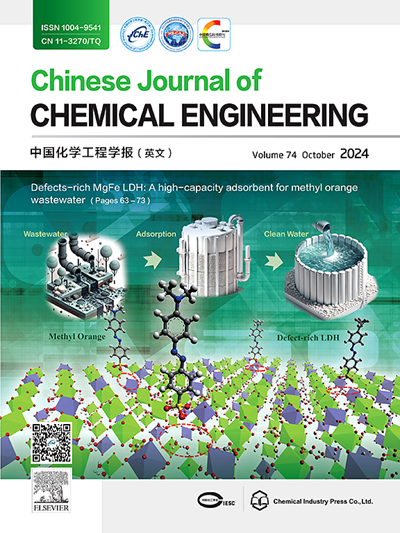液态CO2与海水体积比对海底沉积物中CO2水合物固存的影响
IF 3.7
3区 工程技术
Q2 ENGINEERING, CHEMICAL
引用次数: 0
摘要
海底沉积物中以水合物为基础的CO2固存具有巨大的碳减排潜力。考虑到水合物形成过程中CO2与水的比例关系,它们的存在比在很大程度上决定了CO2固存密度和相态。在这里,这项工作的重点是确定20 - 40目(0.42 - 0.85毫米)石英砂模拟沉积物中CO2与海水的最佳比例,以最大限度地提高沉积物中CO2水合物的转化率。结果表明:CO2水合物转化率随着初始含水饱和度的增大而增大,在初始含水饱和度为80%时达到15.3%;初始含水饱和度为30%时,CO2水合物形成最佳,对应的CO2水合物储存密度为33.09 kg·m−3,水合物饱和度为22.3%。然而,CO2水合物转化率为10%,这意味着尽管存在自由水,大多数CO2仍以液态存在。总CO2固存密度与初始含水饱和度呈负相关,在初始含水饱和度为10%时,固存了398.73 kg·m−3的CO2,其中只有18.02 kg·m−3是水合的。初始含水饱和度越低,CO2消耗t90的时间越短,在初始含水饱和度为10%时,水的水合物转化率达到90%。综上所述,调整液态CO2与海水的体积比可以有效增加CO2水合物的固存量,但增加CO2转化为水合物的方法还有待建立。本文章由计算机程序翻译,如有差异,请以英文原文为准。
Influence of volume ratio of liquid CO2 to seawater on CO2 hydrate sequestration in submarine sediments
CO2 hydrate-based sequestration in submarine sediments shows great potential for carbon emission reduction. Considering the proportional relationship of CO2 and water for hydrates formation, their existing ratio largely determines the CO2 sequestration density and phase state. Here, this work focuses on determining the optimal ratio of CO2 to seawater in sediments simulated with 20−40 mesh (0.42−0.85 mm) quartz sand, in order to maximize CO2 hydrate conversion in sediments. The results show that the conversion rate of CO2 hydrate increases with the initial water saturation, reaching 15.3% at 80% initial water saturation. The optimal CO2 hydrate formation occurs at 30% initial water saturation, with the corresponding CO2 storage density in hydrate form of 33.09 kg·m−3 and the hydrate saturation of 22.3%. However, CO2 hydrate conversion rate is <10%, which implies that most CO2 still exists in liquid state, despite the presence of free water. The total CO2 sequestration density is negatively correlated with the initial water saturation, and at 10% initial water saturation, 398.73 kg·m−3 of CO2 is sequestered, of which only 18.02 kg·m−3 is hydrated. Additionally, the lower initial water saturation corresponds to the shorter time to achieve t90 of CO2 consumption, and the water conversion rate to hydrate reaches 90% at 10% initial water saturation. In summary, adjusting the volume ratio of liquid CO2 to seawater can effectively increase the sequestration amount of CO2 hydrates, but methods to increase CO2 conversion to hydrate still need to be established.
求助全文
通过发布文献求助,成功后即可免费获取论文全文。
去求助
来源期刊

Chinese Journal of Chemical Engineering
工程技术-工程:化工
CiteScore
6.60
自引率
5.30%
发文量
4309
审稿时长
31 days
期刊介绍:
The Chinese Journal of Chemical Engineering (Monthly, started in 1982) is the official journal of the Chemical Industry and Engineering Society of China and published by the Chemical Industry Press Co. Ltd. The aim of the journal is to develop the international exchange of scientific and technical information in the field of chemical engineering. It publishes original research papers that cover the major advancements and achievements in chemical engineering in China as well as some articles from overseas contributors.
The topics of journal include chemical engineering, chemical technology, biochemical engineering, energy and environmental engineering and other relevant fields. Papers are published on the basis of their relevance to theoretical research, practical application or potential uses in the industry as Research Papers, Communications, Reviews and Perspectives. Prominent domestic and overseas chemical experts and scholars have been invited to form an International Advisory Board and the Editorial Committee. It enjoys recognition among Chinese academia and industry as a reliable source of information of what is going on in chemical engineering research, both domestic and abroad.
 求助内容:
求助内容: 应助结果提醒方式:
应助结果提醒方式:


